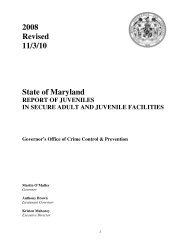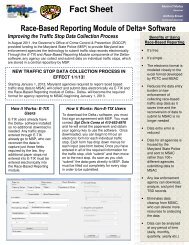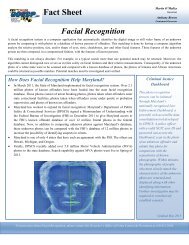Targeted Outreach - Governor's Office of Crime Control & Prevention ...
Targeted Outreach - Governor's Office of Crime Control & Prevention ...
Targeted Outreach - Governor's Office of Crime Control & Prevention ...
You also want an ePaper? Increase the reach of your titles
YUMPU automatically turns print PDFs into web optimized ePapers that Google loves.
38 <strong>Targeted</strong> <strong>Outreach</strong><br />
Case management, including completing an intake<br />
form when the youth starts and tracking the youth’s<br />
monthly progress, is very different from the typical<br />
Boys & Girls Club procedure. Although our earlier<br />
work with Boys & Girls Clubs indicated that staff are<br />
generally aware <strong>of</strong> and “watch out” for youth who<br />
participate in their area’s activities, there is usually<br />
no formal mechanism for keeping in touch with<br />
youth outside their program area or outside the Club<br />
(Gambone and Arbreton, 1997). The intention<br />
behind “tracking” youth and their progress in<br />
GPTTO and GITTO is to ensure that Club staff are<br />
helping build youth strengths and meet the needs<br />
they might otherwise turn to the gang lifestyle to fulfill.<br />
Also, by paying attention to how the youth is<br />
doing in other domains <strong>of</strong> his or her life (e.g., at<br />
school, at home and, if necessary, in contact with the<br />
justice system), the staff member tries to communicate<br />
to the youth that a number <strong>of</strong> people care about<br />
them and their activities. Finally, documentation <strong>of</strong><br />
youth’s progress is encouraged as an important indicator<br />
<strong>of</strong> how well the initiatives are working for the<br />
target youth.<br />
Case Management in <strong>Prevention</strong> Clubs<br />
The GPTTO prevention model suggests that case<br />
management responsibilities be divided among staff<br />
members, a procedure with multiple potential benefits.<br />
First, case management and its paperwork are<br />
time consuming, and dividing it among staff leaves<br />
more time for staff to interact with youth and run<br />
programs. Second, this system allows a youth to hook<br />
up with a staff person with whom they might be most<br />
likely to engage. For example, if the youth is interested<br />
in art, the art director might be the most<br />
appropriate person to track the youth, who is likely<br />
spending the most time in the art room and developing<br />
a strong relationship with staff there. Dividing up<br />
the responsibilities for tracking may also potentially<br />
keep the program running more smoothly in light <strong>of</strong><br />
the continual staff turnover that Clubs face. If one<br />
person tracks all the GPTTO youth and builds relationships<br />
with them, and that person leaves, many <strong>of</strong><br />
the target youth might also leave if they have not<br />
bonded with other staff members.<br />
Clubs divided the responsibilities for tracking in different<br />
ways. About one-third <strong>of</strong> the prevention Clubs<br />
used 2 to 3 staff members for case management, onethird<br />
used 4 to 7 and one-third used 8 to 10. Five<br />
Clubs reported that the best way to ensure the quality<br />
<strong>of</strong> tracking, programming and documentation was<br />
not only to divide the tracking responsibilities among<br />
program staff, but to assign one person as the overall<br />
program coordinator, who would be responsible for<br />
overseeing and coordinating all paperwork and case<br />
management. Thus, the staff working with the youth<br />
in the program area where the youth spent time were<br />
kept informed about the youth, but a central<br />
“<strong>Targeted</strong> <strong>Outreach</strong> Coordinator” completed and<br />
filed the paperwork. In five <strong>of</strong> the Clubs where this<br />
structure was not utilized, the evaluation contact person<br />
indicated that he or she thought additional funding<br />
to support a <strong>Targeted</strong> <strong>Outreach</strong> Coordinator<br />
would benefit the youth and the Club.<br />
Case Management in Intervention Clubs<br />
Case management took a different form in the intervention<br />
Clubs, where youth are part <strong>of</strong> a separate<br />
project with designated staff (in contrast to prevention<br />
Clubs, where GPTTO responsibilities are just<br />
one <strong>of</strong> many). One intervention Club utilized outreach<br />
coordinators responsible for recruiting, case<br />
managing and completing paperwork for approximately<br />
10 to 30 youth each. Another intervention<br />
Club relied on two program staff, one in each <strong>of</strong> two<br />
program settings, to case manage and complete documentation<br />
on approximately 8 to 10 youth each.<br />
One intervention Club assigned a case manager to<br />
complete the intake and tracking on the 35 youth<br />
who were part <strong>of</strong> the evaluation; however, four<br />
months into the evaluation, funding allocated specifically<br />
for the position ended and, thereafter, no tracking<br />
forms were completed (at that site, program<br />
coordinators at each <strong>of</strong> eight locations were responsible<br />
for documentation on 25 youth as part <strong>of</strong><br />
requirements for a city grant; however, these 200<br />
youth were not necessarily in the P/PV evaluation).<br />
Monthly Tracking Challenges<br />
Case managers’ completion <strong>of</strong> monthly tracking<br />
forms was not uniform for all youth and decreased<br />
over the 12 months <strong>of</strong> the program. Four and eight<br />
months after intake, Club staff submitted tracking<br />
forms on about three-quarters (78% and 74%,<br />
respectively) <strong>of</strong> the GPTTO youth and about half<br />
(55% and 53%, respectively) <strong>of</strong> the GITTO youth<br />
originally enrolled in the program. One year after<br />
intake, staff completed tracking forms for 62 percent<br />
<strong>of</strong> GPTTO and 46 percent <strong>of</strong> GITTO youth.

















